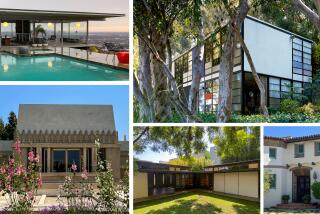History in the Remaking
- Share via
As you climb the narrow staircase in Simi Valley’s historic Strathearn house, sunlight gushes down from a skylight. The window must be a recent addition, you sigh, a contemporary aberration in this fine old house.
Wrong. More than a century ago, Robert Strathearn built this roomy Victorian home onto the end of a two-room adobe house that was already nearly 100 years old. The fact that he designed it with a skylight back then is as intriguing as why he even bothered to save the roofless adobe.
These are the kind of questions you’ll ponder if you tour the house-turned-museum, which has reopened after a three-year hiatus for repairs and upgrades following the 1994 Northridge earthquake.
The 6.7-magnitude quake was merciless. The chimney crashed through the roof, and the walls on the adobe portion were badly cracked. There was no choice but to shut down the home, the centerpiece of the Strathearn Historical Park and Museum.
But in May the house reopened with fanfare. The hourlong docent-led tours have resumed on Wednesday, Saturday and Sunday and there is little evidence of the havoc wrought by the temblor.
“The cracks were big enough to see through,” said Patricia Mosley, a docent for the Simi Valley Historical Society, which manages the house and other historic buildings on the six-acre spread.
There is a positive side to the earthquake. The repair work exposed the home’s original adobe bricks and dirt floor. Visitors can still see them through a plexiglass-enclosed opening.
The adobe, a state historical landmark since 1988, is believed to have been built by Santiago de la Cruz Pico, a soldier who received a Spanish land grant in 1795 for about 100,000 acres.
He grazed cattle on the grounds, and later sold the property to Jose de la Guerra, a prominent Mexican rancher. By the time Strathearn bought part of the ranch in the early 1890s, the large adobe was still standing--minus its roof.
Strathearn, originally from Scotland, built a two-story Victorian farmhouse that he attached to the old structure. Instead of a flat roof, he topped the adobe with a peaked roof and turned it into the kitchen and dining room for his family of nine.
Known simply as “the boss,” Strathearn ran cattle on the ranch and is credited with bringing the first hornless Angus from Scotland to California. His descendants lived in the house until 1969, when they donated it to the Rancho Simi Recreation and Park District for a museum.
At first glance, you don’t see the adobe portion tucked behind the sturdy white-frame house with its broad porch and high, peaked roof. The original picket fence still surrounds the house. When you walk into the adobe with its 3-foot-thick walls, don’t expect to see a kitchen from the rancho period. The Strathearns remodeled it in 1959, installing all the latest conveniences, including a dishwasher, garbage disposal and linoleum flooring.
But the rest of the house looks much as it might have around the turn of the century. If it reminds you of the striking Australian-outback house in the TV movie, “The Thorn Birds,” that’s because it was used for the filming.
It has fine woodwork throughout--from the dark wainscoting to the staircase. Downstairs, one of the rooms served as Strathearn’s office. It has a separate entrance for the scruffy cowboys who worked the cattle.
A few of the Strathearn’s furnishings still remain, including a massive dining room table that the elder Strathearn brought from Scotland. Incredibly, a Christmas cactus planted by his wife still survives. It could be as old as 100 years, and it still blooms every Christmas.
Upstairs, the bedrooms are considered roomy by tight Victorian standards, and they all have spacious closets, another deluxe feature for the times, Mosley said. One of the bedrooms is furnished with an elegant oak bedroom set donated by the family of Thomas Bard, a 19th century U.S. senator from Ventura County.
The home’s three-year closure not only provided time for $166,000 worth of earthquake repairs and seismic retrofitting work, but it gave the historical society a chance to upgrade and catalog its furnishings.
If you visit this tree-studded park with it stone-bordered walkways, the Strathearn home is obviously the biggest draw. But there are several other sights to see.
The Colony House, moved to the park in 1970, is one of 12 prefab homes shipped to Simi Valley in the late 1800s by a group of Chicago businessmen who hoped to set up a health resort called Simiopolis. The kitchen in this two-story Victorian is stuffed with vintage knickknacks.
The city’s first library sits here, along with barns moved from the Wood Ranch to house a collection of farm equipment and tools. In the visitor center, you can peruse old photographs and maps from early Simi days.
BE THERE
Strathearn Historical Park and Museum, 137 Strathearn Place, Simi Valley, is open for free docent-led tours on Wednesdays at 1 p.m., Saturdays and Sundays, from 1-4 p.m. For information, 526-6453.
More to Read
Sign up for Essential California
The most important California stories and recommendations in your inbox every morning.
You may occasionally receive promotional content from the Los Angeles Times.










